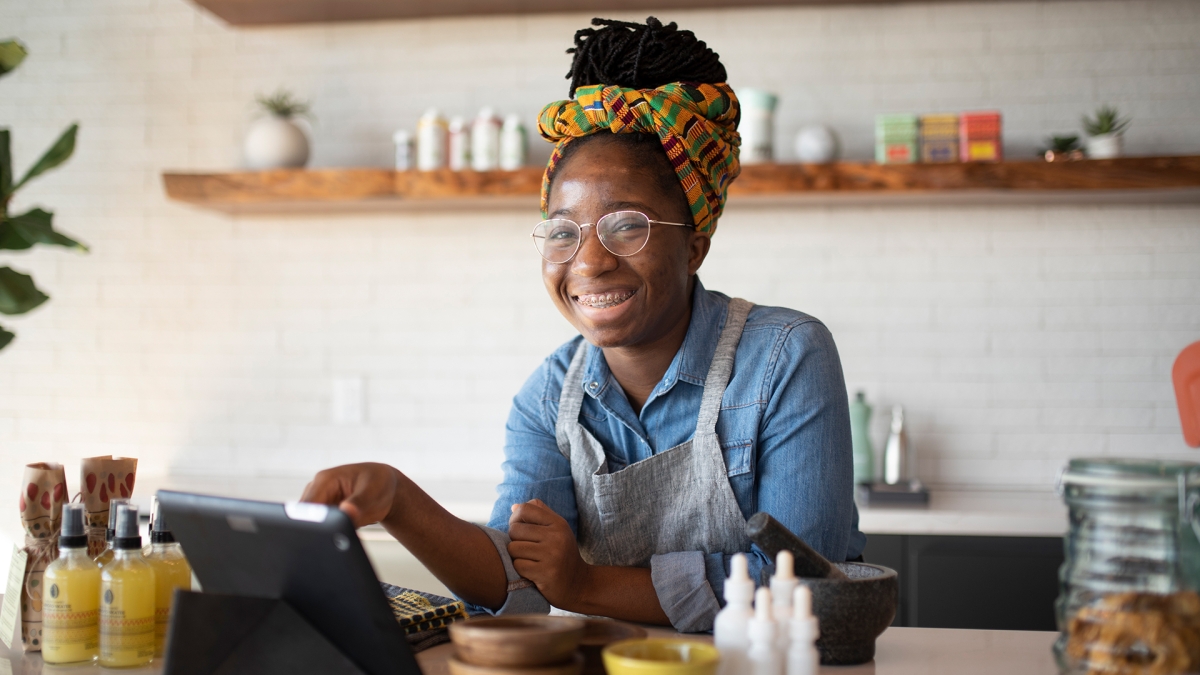Editor's note: This story originally appeared in the winter 2021 issue of ASU Thrive magazine.
It’s one thing to create a good idea, but it’s a challenge to turn that idea into a profitable and sustainable product or service. Having access to mentoring, education and financial support greatly increases the odds of success.
Community members and ASU alumni, students and faculty can take advantage of several entrepreneurial resources through the J. Orin Edson Entrepreneurship and Innovation Institute, from workshops to mentoring to funding. Much of the funding is awarded through biannual Demo Day competitions where ventures deliver pitches as they compete for hundreds of thousands of dollars.
To date, more than 600 entrepreneur teams are impacting the world with the support and financial backing of ASU and philanthropists. Here are just a few powerful examples.
Freda Sarfo: A fruit offers opportunity in Ghana
While tropical almonds (known locally as Abrofo Nkate) have long been consumed as a local sweet in Ghana, they haven’t always been viewed as a source of economic prosperity. After learning from a horticultural engineer about the promising yet undervalued benefits of the tree, Ghana-born Freda Sarfo dug deeper. She learned the fruits have a high-quality cosmetic oil, more protein than chicken and more fiber than oats.
“We started doing more research into the nutritional composition of the tropical almond, how it benefits the body,” Sarfo said. “And there weren’t any products on the market with it.”
Sarfo, a master’s degree student in global logistics and a Mastercard Foundation Scholar, applied for Venture Devils and won $4,000 in 2019. She says that her study of supply chain and logistics has helped her in establishing Tropical Almond.
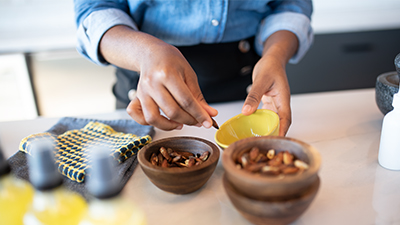
Freda Sarfo started Tropical Almond after winning seed funding from Venture Devils.
“In our business strategy, because there are no established tropical almond farms, we source from tropical almond trees in communities and homes from different regions across Ghana. Without these trees, our business wouldn’t be. My knowledge and experience from ASU has helped me to design and manage our diverse supply chain effectively and efficiently. I occasionally went to Dr. Dale Rogers with questions on Tropical Almond’s supply chain, and he was always happy to assist with his advice and suggestions.”
In establishing Tropical Almond, she used the funds to travel back to Ghana, educate people on the trees’ benefits and create a business plan. She built a small processing facility and now pays women to collect and crack the fallen nuts then cold press them to retrieve the oil. The company also makes high-protein snacks using the almonds. Tropical Almond currently works with about 60 women, mostly single mothers. It has significantly helped during the pandemic as many of these women lost other odd jobs.
Through outreach, the Tropical Almond team also has saved more than 100 trees that would have been cut down. In addition, for every bottle of almond oil sold at the online store, the company donates a bag of high-protein snacks to hungry children.
“Our tactic was to help these mothers find social income, reliable income so they can take care of their children and families,” Sarfo said.
Shruti Gurudanti and Mayank Mishra: Addressing loneliness among seniors
Even before the pandemic, loneliness was a growing problem among seniors. It has worsened, with more than half of adults ages 50 to 80 reporting feeling isolated, according to a June 2020 University of Michigan National Poll on Healthy Aging.
Years ago after witnessing a loved one’s struggle, Shruti Gurudanti sought ways to address social isolation. In 2018, she co-founded televëda with Mayank Mishra. Soon after, at a community networking event, Mishra met Kristin Slice, the senior program manager for Peoria Forward, an Edson E+I Institute program in partnership with the city of Peoria for community members. The support helped the co-founders further develop televëda, which acts like a virtual senior community center and addresses senior isolation using easy-to-use technology, including live interactive classes and games, as well as streaming events. Participants can see the instructor, talk to other participants and compete. Examples include multiplayer bingo, interactive fitness classes, live music from the Chandler Symphony Orchestra and other musicians, and tailored interactive education classes. All of this helps older adults build and maintain friendships and feel more engaged and satisfied with life.
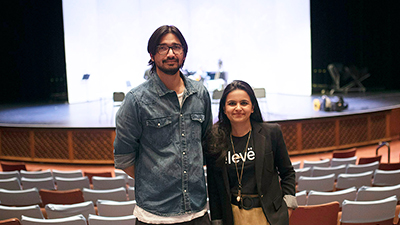
Mayank Mishra and Shruti Gurudanti at a livestream event for their company that helps reduce senior isolation.
Since its founding, televëda has created virtual senior communities that have helped more than 1,500 users, including seniors in nursing homes, assisted living facilities and their homes.
Recently, Gurudanti heard from a widower who uses the platform to socialize. “He keeps coming back to these classes. What’s beautiful is that he doesn’t feel like he’s coming to a support group. For me, that’s a success,” Gurudanti said.
In May 2020, at the Greater Phoenix Tech Challenge, the company won a $50,000 grant from the Pakis Center for Business Philanthropy at the Arizona Community Foundation. Televëda will use the funds to expand from its current seven employees.
“Our goal is to be a widespread virtual recreation center to reduce social isolation, and so people don’t have to worry about feeling lonely again,” Gurudanti said.
Dylan Lang: Improving communication for people with hearing loss
Over the course of three years between high school and college, ASU computer science senior Dylan Lang lost nearly 90% of his hearing because of a condition called profound bilateral hearing loss. While learning to deal with his ailment, Lang developed an interest in computer science and artificial intelligence and applied that knowledge to developing a smartphone app to help people with hearing loss. In the app, which Lang expects to make public in a few years, the webcam views a person’s hand motions, then AI converts that information to text. In reverse, a person speaks, then AI makes the hand motions on the screen.
“I’ve seen how the lack of resources impacts the deaf community,” Lang said. “There’s often a communication barrier, and (the deaf) have to communicate with notes or notepads. Interpreters aren’t always around.”

Dylan Lang aims to improve communication for people with hearing loss; he is shown here against a green screen capturing movements for an avatar.
Lang, who is president of the Deaf Devils student organization, demonstrated the concept at the first Demo Day in 2018 and won $35,000 to turn the idea into a company named EqualComm. Lang is testing the machine learning output and credits the J. Orin Edson Entrepreneur and Innovation Institute and Brent Sebold, a lecturer and administrator of entrepreneurship and innovation programs, for helping him fine-tune the concept.
“I think the app can empower (deaf) individuals to bridge the communication gap when they are out in the community,” Lang said.
Ryan Stoll: Reducing anxiety in children
While working on his PhD in clinical psychology at ASU, Ryan Stoll discovered in one-on-one sessions he facilitated that many people struggle with similar anxiety issues. He thought that maybe there was a way to proactively help people using evidence-based tactics.
With years of research around anxiety at the Courage Lab at the ASU Department of Psychology, combined with assistance through ASU’s entrepreneurial ecosystem, in 2017 Stoll came up with a six-lesson game-based anxiety prevention program for children called Compass for Courage.
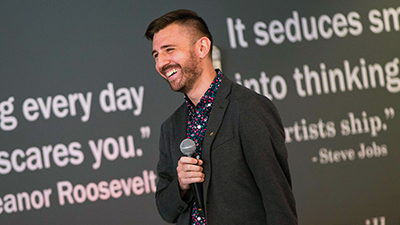
Ryan Stoll delivering a five-minute pitch at a Demo Day competition.
After going through the classes and mentorship offered by the J. Orin Edson Entrepreneurship and Innovation Institute at ASU’s program Venture Devils and refining his idea, Stoll created and mastered a five-minute “Shark Tank”-like pitch for Demo Day, which landed Compass $34,500 in funding in 2017 from the Changemaker Challenge and the Edson Student Entrepreneurship Initiative.
“It enabled me to create a brand around the science, design the program and order the first 100 kits,” Stoll said. “The funding and ability to use the ASU platform have opened new opportunities for the business.”
The project received another $30,000 the following year during Demo Day and has so far trained counselors in 55 Arizona schools and helps about 350 students each year. With ASU’s help, Stoll has been able to conduct research that shows improvements in patients’ emotional awareness and their ability to gain more confidence in stressful situations because of Compass for Courage.
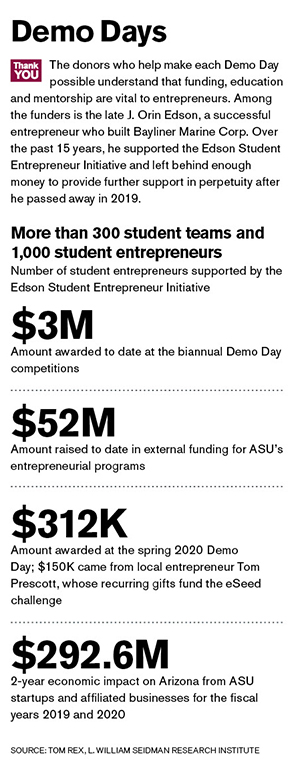
Watch entrepreneurial Sun Devils
Learn more about the establishment of the J. Orin Edson Entrepreneurship + Innovation Institute and hear from startup founders from five ventures about their journeys: EqualComm, Phoenix Coqui, Pura Vida Grinds, Navi Concierge Nurses and NeoLight.
Get help with your innovative idea
Have a new product, service, process or business idea? Join a comprehensive ecosystem that includes support, funding sources, mentors, innovation spaces, academic courses and community programs that help all entrepreneurs thrive. This includes the new Venture Devils+ for winners of seed funding at a Demo Day competition, which provides the ability to apply for additional mentoring over the course of a semester.
Top photo: Freda Sarfo started her business in her kitchen, formulating products made from tropical almonds found on ornamental trees in her native Ghana.
Story by Craig Guillot. He is a business journalist whose work has appeared in The Wall Street Journal, Forbes, Chief Executive and Entrepreneur magazines.
Because of you, a future full of promise: Explore how ASU supporters’ generosity during Campaign ASU 2020 has powered many breakthroughs and successes, and laid the groundwork for a future full of possibilities.
More Business and entrepreneurship

With help from ASU and a viral TikTok, an entrepreneur soars
Nearly five years ago, Ruben Trujillo saw his entrepreneurial dream slipping away as he wondered how he would pay his rent.Now, Trujillo’s business, Café Emporos, is featured on a national TV…

Honoring 2 decades of entrepreneurial impact on a global scale
Thunderbird for Good, the impact-driven initiative of Thunderbird School of Global Management at Arizona State University, is marking two decades of educational programs and initiatives dedicated to…

ASU and GoDaddy launch Student Athlete Venture Studio
In a groundbreaking initiative aimed at empowering college athletes beyond their playing careers, Arizona State University and GoDaddy teamed up to launch the first-of-its-kind Student Athlete…


